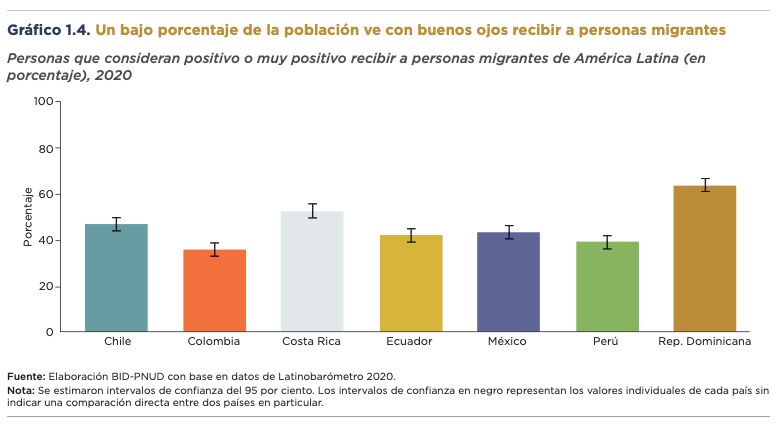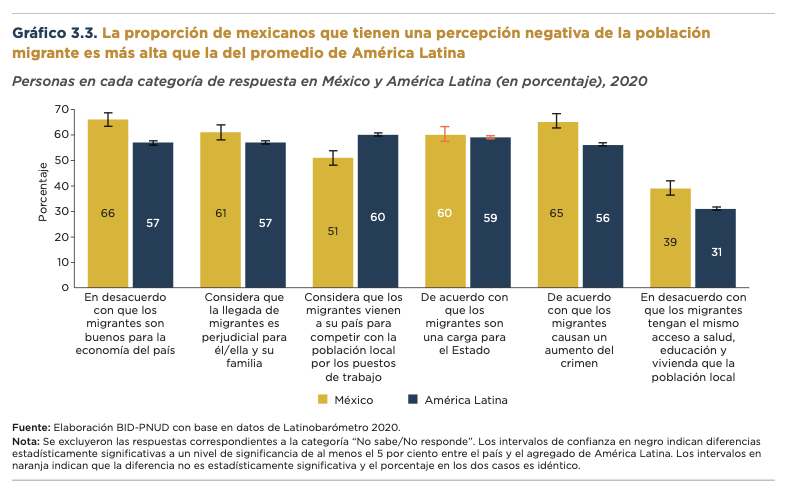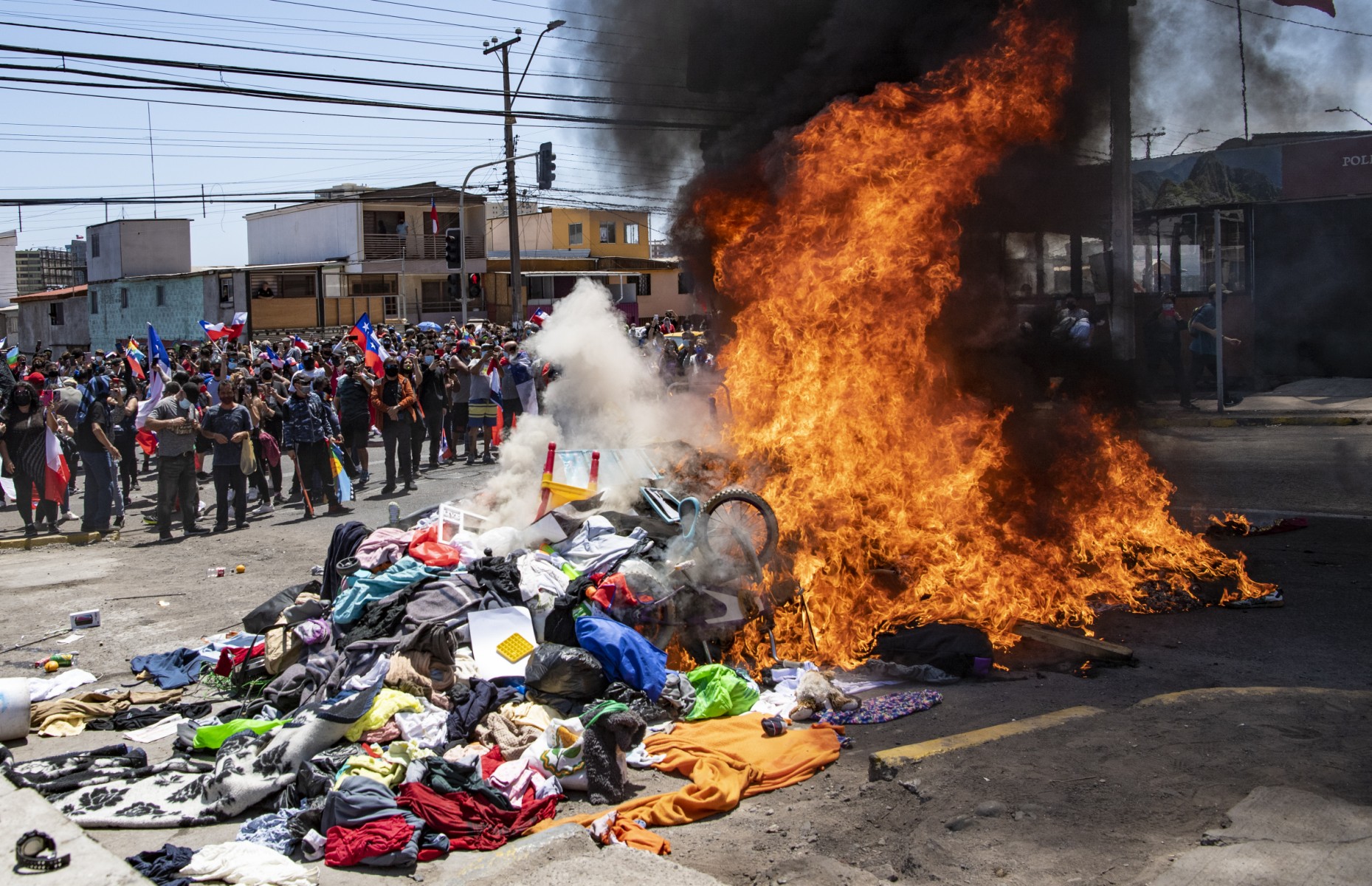
A report by the Inter-American Development Bank (IDB) and the United Nations Development Program (UNDP) reveals that 62% of the population of Latin America and the Caribbean does not agree with receiving Venezuelan migrants. The data comes from our own elaboration based on data from Latinobarómetro 2020 and Gallup surveys from 2016 and 2019.
The population of Peru (81%) and Ecuador (80%) is the one that expresses the highest rejection of the arrival of Venezuelan migrants. Colombia, the country that receives the most Venezuelan migration, also expressed high rejection (79%): “The predisposition of Colombians to receive migrants in general is low, but the data reveals that it is even less in the face of Venezuelan migration.”
In recent years, Latin America and the Caribbean has welcomed more than 80% of the Venezuelans who migrated, totaling around 6.8 million people, up to August 2022.

Venezuelan migrants
“A better world for the migrant population in Latin America and the Caribbean”, as the report is titled, points out that the region went from hosting 7 million migrants in 1990 to having a migrant population of 15 million in 2020. “The massive migration crisis in Venezuela, which constitutes the most significant exodus in recent 50 years in the Western Hemisphere has spawned one of the most challenging diasporas in the world given its intensity in a short period of time. Around 6.8 million Venezuelan people have emigrated as of August 2022”, he indicates.
Although migration boosts productivity, stimulates innovation and generates more diverse societies, such sudden flows cause pressures that affect poverty, development and demographic dynamics. Xenophobia has also been exacerbated.
It also explains that “the local population may fear a deterioration in their economic situation as a consequence of the arrival of the migrant population through the worsening of their working conditions and the increase in the tax burden.” You may also have the perception that crime and delinquency increase with the arrival of migrants. This is a common narrative in the region.
“Ignorance of the reality of the migrant population and misperceptions about migration reinforce group identity while exacerbating discrimination and xenophobia,” he says.
The report details some experiments to try to “positively change the attitude that the local population tends to have about immigration.” Interventions were carried out in Peru, Ecuador, Colombia, Mexico, Chile, Trinidad and Tobago, the Dominican Republic, Costa Rica, and Barbados.

Peru, high rejection
“Peru is among the largest recipients in the world of migrants from Venezuela, and registered a total of 941,000 Venezuelans in June 2020, a figure second only to Colombia,” the report indicates.
“In 2022, according to the annual report on global trends of the United Nations High Commissioner for Refugees (Acnur), Peru has more than 1.2 million migrants from Venezuela, of which around 80% reside in Lima, which represents 8% of the population of working age that lives in the capital”, he adds.
The report points out that in Peru opinions about migrants are ambivalent and express a negative trend in recent years: “The main concerns of the local population are related to perceptions that associate the arrival of the migrant population with an increase in crime and an increase in labor competition.
81% of the population is concerned about the arrival of Venezuelan migrants and considers that it is negative to receive them.

Venezuelan migrants in Ecuador
Since 2019, the country has been among the largest Venezuelan migrant recipients, with 389,000 people registered as of June 2020, according to United Nations data, it adds.
Due to the increase in migrant population flows from Venezuela, Ecuador toughened its migration policy in 2018.
“In Ecuador, as in other South American countries, public opinion towards the migrant population, especially those from Venezuela, has deteriorated with the increase in migratory flows in the last five years,” he says.
“57% consider it negative to receive migrants from outside Latin America, compared to a Latin American average of 48%. However, the rejection of migrants from the region is stronger (58%), especially those from Venezuela (80% in Ecuador and 62% in Latin America)”, he points out.

Colombia, receptor
“Colombia is currently a sending, receiving and migratory transit country,” the report highlights.
Colombia is also one of the main recipients of Venezuelan migrants. “Migration of Venezuelan origin has the vocation of both permanence and transit. It is also a heterogeneous migration, mostly of people in conditions of high vulnerability. 92% of Venezuelan migrants say that the reason for migrating was the need to seek better economic conditions”, says the report.
“In general, Colombians have a much more negative perception than the average for the region regarding the arrival of migrants,” he details: 67% of Colombians think that migrants are a burden to the State, 68% believe that Migrants cause an increase in crime and 65% believe that migrants compete with the local population for jobs.
In the case of Venezuelan migrants, 79% of Colombians do not want their country to receive them.

Mexico does not want Venezuelan migrants
In addition to having greater resistance to the migrant population, in general, than the average for the Latin American population, the rejection of Venezuelan migrants is more frequent than that directed at the migrant population of other origins, says the report.
66% consider it negative to receive migrants from Venezuela, 57% express the same regarding the migrant population from other Latin American countries and 58% consider it negative to receive migrants from outside the region.
more open chili
The report, based on data from Latinobarómetro 2020 and Gallup polls from 2016 and 2019, shows that in Chile 64% of the population considers it negative to receive migrants from Venezuela. 71% of the Chilean population believes that migrants come to compete with the local population for jobs. Similarly, 73% of the Chilean population believes that migrants cause an increase in crime.
Chile is more open to migration when it comes from outside the region.
Trinidad and Tobago, complex
Venezuelan migration in Trinidad and Tobago has gone from representing 3% of total migrants in 1990 to constituting a little more than 30% in 2020, the report highlights.
An estimated 34,100 Venezuelan citizens lived in Trinidad and Tobago in 2022. Also, according to the report, the country has received more than 20,000 asylum requests from Venezuelan citizens between 2015 and 2021.
“As in other islands in the southern Caribbean, the Venezuelan exodus to Trinidad and Tobago has been especially complex, given its territorial proximity, its land extension, and its limited institutional capacities to absorb migrants,” he adds.

6% of the migrant population in the Dominican Republic
In 2020, 82% of the migrant population residing in the Dominican Republic was Haitian. “The development of the Dominican agricultural sector, added to the poverty and insecurity prevailing in Haiti, are among the causes of this migratory pattern,” the report indicates.
The country has also received, more recently, migrants from Venezuela who arrive in search of opportunities in the face of the political and economic instability that exists in their country, he adds: In 2020 the Venezuelan population represented 6% of the migrant population in the Dominican Republic .
“Despite having less resistance to intra-regional migration than the Latin American average, the Dominican Republic stands out because a greater proportion of its population considers it negative to receive migrants from Haiti (the percentage is 74% in the country and than 61% in Latin America) and a smaller proportion considers it negative to receive migrants from Venezuela (50% compared to 62% in the region)”, he specifies.
Costa Rica, equal to the average
The most frequent origins of migration in Costa Rica, after Nicaragua, are Venezuela and Colombia.
62% of the Costa Rican population believes that migrants cause an increase in crime, 65% agree that the migrant population is a burden to the State, and 38% disagree that migrants have the same access to health, education and housing than the national population.
48% of Costa Ricans consider it negative to receive migrants from Latin America and other regions, a percentage that is equal to the average for Latin America.
Barbados, no data
There is a gap when it comes to studies that analyze and provide evidence on the impact of migration in Barbados, especially when it comes to the most recent migration flows, the report notes.
Since there have been no massive migratory flows in recent years, their effects have not been documented, he adds.
